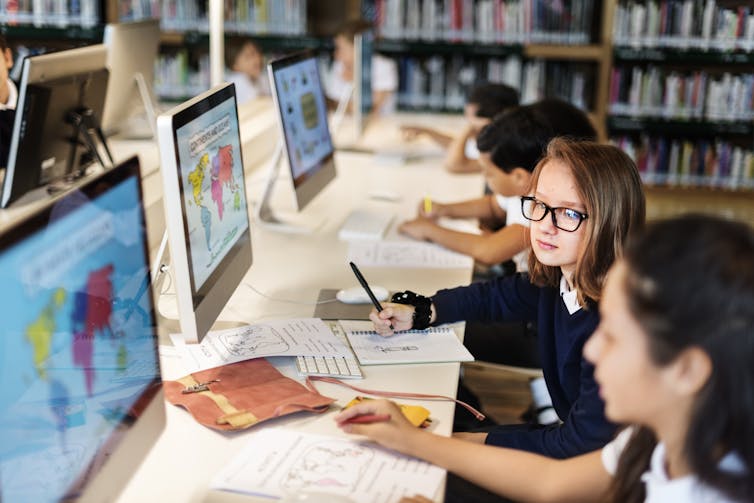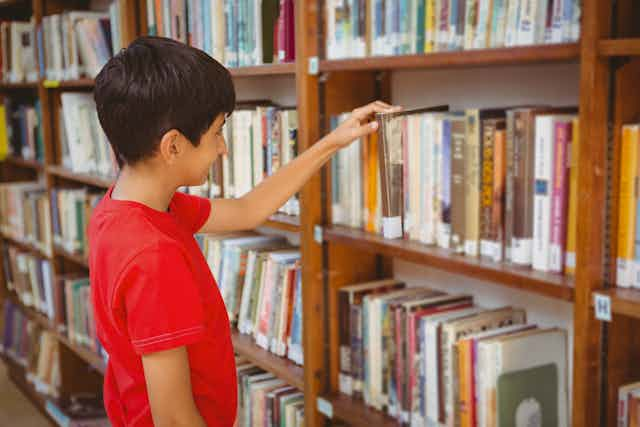A recent article about a new approach to a school library sparked vigorous discussion on social media. Many worried the school had completely abolished traditional library services. The article describes how a Melbourne school changed its library to a technology-focused centre staffed by “change adopters” who host discussions with students and encourage creative thinking.
The school’s principal was forced to defend the library’s restructure. She wrote that its traditional purpose hadn’t been lost.
The College Library has been transformed into a Learning Centre that continues to offer all library services to students and staff, including a significant collection of fiction and non-fiction books, journals, newspapers, magazines and other print resources, as well as online access to other libraries.
This school’s approach isn’t unique. Many schools have reconfigured their library spaces to embrace a model of integrating library services – where traditional library resources are combined with technology. Some have installed new technologies in so-called “maker spaces”. These are where students can be creative, often using technologies such as 3D printers and recording suites.
The purpose of today’s libraries isn’t only to maintain the traditional roles of promoting reading, developing information literacy and providing access to a collection of books and other resources. Today’s school libraries are fundamental to broader digital literacy, information provision and developing critical evaluation of information.
Read more: Technology hasn't killed public libraries – it's inspired them to transform and stay relevant
The importance of the library
School libraries improve student achievement. A synthesis of international studies demonstrates that having a library leads to successful curriculum outcomes, including information literacy and positive attitudes to learning. It also improves academic achievement through higher test or exam scores.
A detailed study of 30 teacher librarians in Australia showed they also play a key role in supporting students with special educational needs. They do this by identifying readers and students at risk and working with them to improve both educational and social outcomes.
Teacher librarians have dual educational and librarianship qualifications. This means they have knowledge of pedagogy and curriculum combined with library and information management skills.

Libraries and library staff have consistently responded to the changing needs of society. And library professionals have been at the forefront of embracing technology: from establishing the first computer labs in schools in the 1980s through to working with students and teachers to use new technologies such as 3D printing, robotics, gaming and recording suites in learning and creativity.
Read more: Technology and learning in the classroom: six tips to get the balance right
Libraries and technology
There is a lack of understanding of what librarians can do for a school community and a belief children don’t need help with learning how to use technology. Information can be inaccessible, and misunderstood, without proper instruction, guidance and support. This is especially true for students from disadvantaged backgrounds who don’t have good access to the internet at home, or those with learning differences.
As the evidence base for what makes an effective library grows, it’s becoming recognised that
the 21st century school library professional is a digital leader, an innovator, a creator, a promoter, a resource and research specialist, a curriculum adviser, and much more.
Teacher librarians educate children in the core skills of searching and evaluating information. They also support and empower students in areas such as digital citizenship. This enables children to fully participate and engage with the complex digital landscape.
As Chelsea Quake, a teacher librarian at a Melbourne public school, told us:
Students leave school reading fake news, turning to Instagram for answers to their health questions, and falling flat on their first university paper, because they never truly learnt how to research.
Skills such as information and digital literacy are core requirements for civic participation. Young people have tremendous opportunities to leverage the power of technologies to ensure their voices are heard about issues that will affect them and their children in the future. And they need new and evolved library services to help them get there.
Read more: Friday essay: why libraries can and must change

